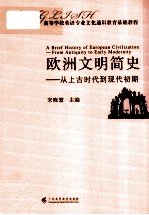

欧洲文明简史 从上古时代到现代初期PDF格式文档图书下载
- 购买点数:12 点
- 作 者:宋晓堃主编 尚劝余 张华鸿 詹俊峰 梅园副主编
- 出 版 社:广州:广东高等教育出版社
- 出版年份:2011
- ISBN:9787536141773
- 标注页数:349 页
- PDF页数:360 页
Part Ⅰ Ancient World 4
Chapter 1 Civilizations in the Ancient Near East1.Introduction 4
2.Civilization in Mesopotamia 5
2.1 Brief history of Mesopotamia 6
2.2 The Cultural Achievements of Mesopotamia 11
3.Ancient Egyptian Civilization 15
3.1 Egypt:"The Gift of the Nile" 15
3.2 A Brief History of Ancient Egypt 17
3.3 Ancient Egyptian Culture and Society 18
4.The Hebrews:History and Religion 24
4.1 "The Children of Israel":A Brief History 25
4.2 Israelite Religion:Judaism 27
5.Conclusion 29
Exercises 30
Chapter 2 Greek Civilization 33
1.Introduction 33
2.History of the Ancient Greeks 34
2.1 Early Greece 35
2.2 The Dark Age(1200—50 BC) 38
2.3 The Archaic Period(750—500 BC) 38
2.4 The Classical Period(500—338 BC) 45
2.5 The Hellenistic Period(323—31 BC) 51
3.Cultural Achievements of the Ancient Greeks 54
3.1 Religion and Mythology 55
3.2 Philosophy 57
3.3 Science 61
3.4 Literature 62
3.5 Historiography 66
3.6 Art 68
4.Conclusion 72
Exercises 73
Chapter 3 Roman Civilization:from A City to An Empire1.Introduction 77
2.Rome:from Republic to Empire 78
2.1 The First Romans and Their Neighbors 79
2.2 The Roman Republic(509—31 BC) 81
2.3 Roman Expansion 86
2.4 The Collapse of the Roman Republic(133—31 BC) 90
2.5 The Early Empire(31 BC—180 AD) 92
3.Roman Culture 96
3.1 Government 96
3.2 Evolution of Roman Law 97
3.3 Roman Engineering and Architecture 98
3.4 Literature 100
3.5 Historiography 103
3.6 Sculpture and Painting 103
3.7 Science 104
4.Conclusion 105
Exercises 108
Chapter 4 Decline of the Roman Empire and Rise of Christianity1.Introduction 111
2.The Crisis of the Empire 113
2.1 The Flawed Imperial Political System 114
2.2 Crisis of the Slave Economy 116
2.3 The Culture of Bread and the Circus 119
3.The Empire Reorganized 122
3.1 Dividing the Empire 122
3.2 The Reign of Constantine(312—395) 124
4.Transformation of the Roman World:the Development of Christianity 125
4.1 Imperial Roman Religious Beliefs 126
4.2 Jews under Roman Rule 128
4.3 The Career of Jesus 128
4.4 The Rise of Christianity 132
4.5 The New Contours of Fourth-Century Christianity 135
5.Transformation of the Roman World:the Germanic Invasion 138
5.1 Early German-Roman Relationship 138
5.2 The Rise of German Kingdoms and the Fall of the Western Roman Empire 142
6.Conclusion 145
Exercises 147
Part Ⅱ The Medieval World 153
Chapter 5 The Early Middle Ages(500—1000) 153
1.Introduction 153
2.The Byzantine Empire 154
2.1 The Reign of Justinian(rule 527—565) 155
2.2 Economy and Society in Byzantium 158
2.3 Byzantine Culture 160
2.4 What Made the Byzantine Empire Strong 163
3.The Rise of Islam 165
3.1 Arabia Before Muhammad 166
3.2 The Founding of Islam 167
3.3 The Religious Teachings of Islam 168
3.4 Conquest of Islam 169
3.5 Economy of the Islamic Empire 171
3.6 Islamic Culture 172
4.The Western Christian World 175
4.1 The Rise of the Frankish Empire 176
4.2 The Disintegration of the Carolingian Empire 179
4.3 Early England 180
4.4 Ninth-Century Invasions 181
4.5 Economy and Society in the Early Middle Ages 182
4.6 Culture in the Christian West 185
5.Conclusion 187
Exercises 188
Chapter 6 The Central Middle Ages(1000—1300) 192
1.Introduction 192
2.Economic Takeoff and Social Change 193
2.1 Agricultural Revolution and Rural Society 194
2.2 The Rise of Trade and Towns 198
3.The Church Triumphant 204
3.1 The Centralized Structure of the Medieval Church 205
3.2 Unifying the Church's Theological Doctrine 208
3.3 Christian Conquests and the Crusades 209
4.The Emergence and Growth of National Monarchies 216
4.1 England 217
4.2 Capetian France(987—1314) 219
4.3 The Land of the Holy Roman Empire:Germany and Italy 220
5.Intellectual Revival and Cultural Development 225
5.1 Education and the Rise of Universities 225
5.2 Philosophy and Theology 227
5.3 Science 228
5.4 Literature 229
5.5 Art 232
6.Conclusion 235
Exercises 236
Chapter 7 Crisis in Late Medieval Western Europe(1300—1500)1.Introduction 241
2.Economic Crisis and Recovery 242
2.1 Agricultural Failure and Great Famine 243
2.2 The Black Death 244
2.3 A New Economic Equilibrium Out of the Depression 246
3.Social Crisis and Popular Unrest 248
3.1 Revolts in the Rural Areas 248
3.2 Revolts in the Cities 250
4.Political Crisis and Recovery 251
4.1 The Hundred Years'War 251
4.2 Political Crisis and Recovery 256
5.The Crisis of the Western Christian Church 260
5.1 The Babylonian Captivity 261
5.2 The Western Schism(1378—1417) 263
5.3 Religious Protest 264
6.Conclusion 267
Exercises 268
Part Ⅲ Transition from Middle Ages to Early Modern EraChapter 8 Renaissance(1350—1600)1.Introduction 275
2.The States of Northern Italy 277
2.1 Milan 277
2.2 Venice 278
2.3 Florence 279
3.Italian Renaissance Culture 280
3.1 Italian Renaissance:Humanism at a Glance 281
3.2 Italian Intellectual Renaissance:Literature and Thought 282
3.3 Italian Renaissance Art 285
4.Northern Renaissance 293
4.1 Northern Christian Humanism 293
4.2 Northern Renaissance Literature 296
4.3 Northern Renaissance Art 299
5.Scientific Accomplishments 301
6.Conclusion 303
Exercises 305
Chapter 9 Reformation(1500—1600) 309
1.Introduction 309
2.Religious and Social Background of the Reformation 310
2.1 The Church of Rome Around 1500 310
2.2 Corruption and Malpractices within the Church 312
3.Luther and the German Reformation 315
3.1 Martin Luther(1483—1546) 315
3.2 Luther's Teachings 316
3.3 The Reformation in Germany 319
4.The Spread of the Protestant Reformation 323
4.1 The Reformation in Switzerland 324
4.2 The Reformation in England 328
5.The Catholic Counter-Reformation 332
5.1 The Council of Trent 333
5.2 New Religious Orders:The Jesuits 334
6.General Effects of the Reformation 336
7.Conclusion 337
Exercises 338
参考文献 343
Keys to Exercises 348
- 《欧洲文明简史 从上古时代到现代初期》宋晓堃主编;尚劝余,张华鸿,詹俊峰,梅园副主编 2011
- 《傅乐成主编中国通史 先秦史》萧璠著 2009
- 《埃及 尼罗河畔的灿烂文明 pride of the nile主编谢曙光, 何侃》谢曙光,何侃主编 2003
- 《世界文明简史》何平,孙莎岚,夏茜等编著 2017
- 《西方文明简史》常晓梅主编 2013
- 《一个青年杂志人的心灵史 《大学时代》主编日志》吴新宇著 2006
- 《主编死了 没有主编才是新媒体》陈序著 2015
- 《世界文化简史》高福进编著 2015
- 《没有蒋介石的台湾(此书为自由时代系列丛书一种,自焚的台独分子郑南榕主编)》 2222
- 《知识学原理丛书 人类简史》何立民著 2015
- 《首届广东省书法研究生论坛论文集》首届广东省书法研究生论坛组委会编 2016
- 《广州越秀古书院》黄泳添,陈明著 2006
- 《发现,让教育更和谐 广东广雅中学和谐优质教育探索》叶丽琳主编 2016
- 《为学生搭建成长之桥 广东华侨中学的创新与发展》王惠,刘鉴,梁彩匀编著 2017
- 《广东历代著者要录 广州府部》广州图书馆编 2012
- 《广东小吃》严金明编著 2002
- 《寻味广东丛书 寻味广州》庄臣著;扬眉插图作者 2013
- 《花城春雷 广州解放与广东剿匪》胡元斌编写 2014
- 《广东民间故事全书 广州 增城卷》广东省文学艺术界联合会,广东省民间文艺家协会编 2010
- 《广东丛书 广州城坊志 卷5》黄佛颐纂 2222
